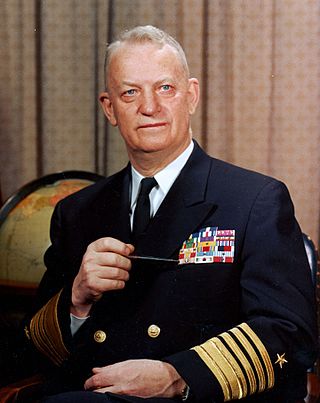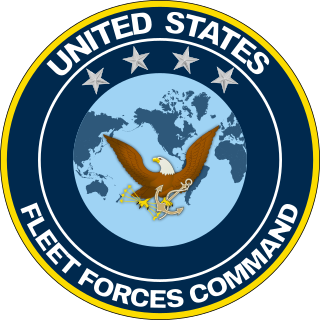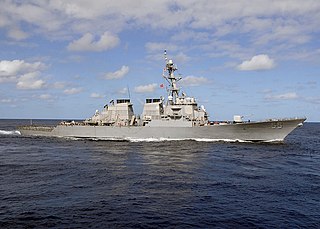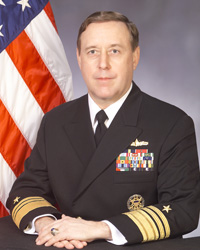
The Arleigh Burke class of guided-missile destroyers (DDGs) is a United States Navy class of destroyer centered around the Aegis Combat System and the SPY-1D multi-function passive electronically scanned array radar. The class is named for Admiral Arleigh Burke, an American destroyer officer in World War II and later Chief of Naval Operations. With an overall length of 505 to 509.5 feet, displacement ranging from 8,300 to 9,700 tons, and weaponry including over 90 missiles, the Arleigh Burke-class destroyers are larger and more heavily armed than many previous classes of guided-missile cruisers.

Arleigh Albert Burke was an admiral of the United States Navy who distinguished himself during World War II and the Korean War, and who served as Chief of Naval Operations during the Eisenhower and Kennedy administrations.

The United States Fleet Forces Command (USFF) is a service component command of the United States Navy that provides naval forces to a wide variety of U.S. forces. The naval resources may be allocated to Combatant Commanders such as United States Northern Command (USNORTHCOM) under the authority of the Secretary of Defense. Originally formed as United States Atlantic Fleet (USLANTFLT) in 1906, it has been an integral part of the defense of the United States of America since the early 20th century. In 2002, the Fleet comprised over 118,000 Navy and Marine Corps personnel serving on 186 ships and in 1,300 aircraft, with an area of responsibility ranging over most of the Atlantic Ocean from the North Pole to the South Pole, the Caribbean Sea, Gulf of Mexico, and the waters of the Pacific Ocean along the coasts of Central and South America.

USS Arleigh Burke (DDG-51), named for Admiral Arleigh A. Burke, USN (1901–1996), is the lead ship of the Arleigh Burke-class guided-missile destroyers. She was laid down by the Bath Iron Works company at Bath, Maine, on 6 December 1988; launched on 16 September 1989; and commissioned on 4 July 1991.

The Spruance-class destroyer was developed by the United States to replace the many World War II–built Allen M. Sumner- and Gearing-class destroyers, and was the primary destroyer built for the United States Navy during the 1970s and 1980s. It was named in honor of U.S. Navy Admiral Raymond A. Spruance, who successfully led major naval battles in the Asiatic-Pacific Theater during World War II such as the Battle of Midway and the Battle of the Philippine Sea.

USS Stout (DDG-55) is the fifth Arleigh Burke-class guided missile destroyer. Built for the United States Navy by Ingalls Shipbuilding, she was commissioned on 13 August 1994 and she is currently home-ported in Naval Station Norfolk. She is part of Destroyer Squadron 26. Stout is named for Rear Admiral Herald F. Stout, who distinguished himself as the commanding officer of the destroyer USS Claxton during World War II. In November 1943, Commander Stout received two Navy Crosses in the span of three weeks for his actions in the Pacific. Stout aided Destroyer Squadron 23 in sinking five heavily armed Japanese warships and damaging four others during the Solomon Islands campaign as well as sinking four more Japanese warships and damaging two others to establish a beachhead on Bougainville Island. Stout was ordered on 13 December 1988, the keel was laid down on 8 August 1991, she was launched on 16 October 1992 and commissioned on 13 August 1994. As of July 2020 the ship is part of Destroyer Squadron 26 based out of Naval Station Norfolk. As of 2023 the Commanding Officer is Cmdr. Desmond Walker, MBA, RBLP-T.

Isaac Campbell Kidd was a rear admiral in the United States Navy. He was the father of Admiral Isaac C. Kidd, Jr. Kidd was killed on the bridge of USS Arizona during the Japanese attack on Pearl Harbor. The highest ranking casualty at Pearl Harbor, he became the first U.S. Navy flag officer killed in action in World War II as well as the first killed in action against any foreign enemy.

The Ticonderoga class of guided-missile cruisers is a class of warships of the United States Navy, first ordered and authorized in the 1978 fiscal year. It was originally planned as a class of destroyers. However, the increased combat capability offered by the Aegis Combat System and the passive phased array AN/SPY-1 radar, together with the capability of operating as a flagship, were used to justify the change of the classification from DDG to CG shortly before the keels were laid down for Ticonderoga and Yorktown.

Ronald A. Route is a retired Vice Admiral and former Naval Inspector General of the United States Navy and a former President of the Naval War College. On July 16, 2013, Vice Admiral Route was named President of the Naval Postgraduate School.

The CG(X) program, also known as the Next Generation Cruiser program, was a United States Navy research program to develop a replacement vessel for its 22 Ticonderoga-class cruisers. Original plans were for 18–19 ships, based on the 14,500 ton Zumwalt-class destroyer with additional ballistic missile defense and area air defense for a carrier group. These vessels were to enter service beginning in 2017. The program was ended in 2010 with its mission to be fulfilled by the successor to the Flight III Arleigh Burke-class destroyers.

Gary Roughead is a former United States Navy officer who served as the 29th Chief of Naval Operations from 2007 to 2011. He previously served as Commander, United States Fleet Forces Command from May 17 to September 29, 2007. Prior to that, Roughead served as the 31st Commander, United States Pacific Fleet from 2005 to 2007. In 2011, he retired from the U.S. Navy after 38 years of service.

Rear Admiral Wayne Eugene Meyer is regarded as the "Father of Aegis" for his 13 years of service as the Aegis Weapon System Manager and later the founding project manager of the Aegis Shipbuilding Project Office. He retired from the United States Navy in 1985 as the Deputy Commander for Weapons and Combat Systems, Naval Sea Systems, Naval Sea Systems Command and Ordnance Officer of the Navy.

The Commander, Naval Surface Force, Atlantic (COMNAVSURFLANT) is a post within the United States Fleet Forces Command. As Naval Surface Force Atlantic, it is a military formation, and the organization is often known as SURFLANT. Its headquarters are at Naval Station Norfolk in Norfolk, Virginia. The current commander is Rear Admiral Brendan R. McLane. COMNAVSURFLANT supervises all surface ships based on the Eastern United States and Gulf Coast of the United States, as well as ships forwarded deployed to Naval Station Rota, Spain.

Destroyer Squadron 23 is a squadron of United States Navy destroyers based out of San Diego, California. The squadron is best known for its actions during World War II, most notably the Battle of Cape St. George, under the command of then-Commodore Arleigh Burke. Currently, the DESRON is assigned to Carrier Strike Group Nine, which includes USS Theodore Roosevelt (CVN-71), USS Chosin (CG-65), USS Lake Erie (CG-70), and Carrier Air Wing Eleven.

Samuel Perez Jr. is a retired rear admiral in the United States Navy.

Derwood Clayiborne Curtis is a retired vice admiral in the United States Navy who served as the Commander, Naval Surface Forces and concurrently Commander, Naval Surface Force, U.S. Pacific Fleet from March 2008 to June 2011.

Carrier Strike Group 10, is a U.S. Navy carrier strike group. As of August 2022, CSG-10 consists of USS George H.W. Bush (CVN-77), the strike group's current flagship, with Carrier Air Wing Seven embarked on board, as well as the Ticonderoga-class cruiserLeyte Gulf, and four ships of Destroyer Squadron 26.

Rear Admiral Jesse Alphonzo Wilson Jr. is a retired United States Navy officer. His last active duty assignment was as commander of Naval Surface Force Atlantic.

John Blackwelder Nowell Jr. is a retired vice admiral in the United States Navy. Nowell assumed duties as the navy's 59th Chief of Naval Personnel on May 24, 2019. Nowell is a distinguished graduate of the United States Naval Academy with a Bachelor of Science in Ocean Engineering and holds a Master of Science in Weapons Systems Engineering from the Naval Postgraduate School.

The DDG(X) or Next-Generation Guided-Missile Destroyer program of the United States Navy aims to develop a class of surface combatants to succeed 22 Flight II Ticonderoga-class cruisers and 28 Flight I/II Arleigh Burke-class destroyers. The program is the culmination of the Large Surface Combatant (LSC) initiative that followed the cancellation of CG(X) and curtailing of the procurement of the Zumwalt-class destroyers. The ships will become the principal large surface combatants of the U.S. Navy; compared to their predecessors, they will incorporate more powerful sensors and have more room and weight margin for growth.




















